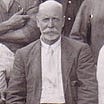Modelling Shear-Legs
Nothing about the shear-legs made the work easy or safe, it just made the impossible plausible ...
I have the honour to report that some say an interest in local history is driven by a wish to uncover the mysteries of your youth, others that it is a preventive from repeating errors of the past. Both worthy, but Joe thinks it’s also interesting to know the answer to “how on earth did they do that?”
Many times, the answer is “with great difficulty and a very high tolerance for risk.” But along with this sometimes comes a glimpse of the long-forgotten knowledge of the elders. So it is with shear-legs, a most useful early invention for lifting awkward weights that was so often applied to lifting pumps and pipes and valves that early Mount Crosbians made great and constant use of them.

The best way I can describe a pair of shear-legs is to say they are a tripod with only two legs. The lateral support is made not with a third leg, but using ropes or wires (called “guys”) that can be adjusted to enable some forward and back movement of the weight, not just up and down like a winch can do.
Shear-legs were probably invented by the Egyptians, but they really came to the forefront when shipwrights had to lift tall masts into place on sailing ships. That’s a truly awkward job, and shear-legs are still commonly used for hoisting and stepping masts and in the salvage of ships. The largest ones can lift more than 2,000 tonnes but, in this essay, we are talking about the old ones, and they are much smaller and more primitive.
When the task involved lifting anything up to about two tonnes, especially in an awkward place, the elders would just about always lash two poles together in the form of shear-legs, get a couple of blokes on the guys, and commence yelling a lot of commands that eventually inched the weight to where it was needed. Nothing about the shear-legs made the work easy or safe, it just made the impossible plausible.
Herewith find some nice photographs of shear-legs in action at Mount Crosby that I hope give an appreciation of the gut-busting inventiveness necessary to build the assets we see all around us.
I remain your ob. Servant and chief engineer (nursing a couple of hernias),
Joe Stewart.






